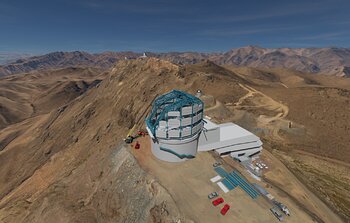Big Astronomy Planetarium Show Now Available for Free Download
December 14, 2023
NSF-funded planetarium program is now online and available for free download

Big Astronomy: People, Places, Discoveries is an award-winning bilingual planetarium show that takes viewers beyond the dome to behind the scenes of some of Chile’s world-class observatories. Meet the people who work with state-of-the-art telescopes in this feature film that is now free and available online for direct download.
Big Astronomy, or Astronomía a Gran Escala, is a multifaceted research and outreach project supported by several partners and funded by the National Science Foundation that showcases the award-winning bilingual planetarium show Big Astronomy: People, Places, Discoveries. The film transports viewers to Chile where the dark skies and dry, remote setting create ideal conditions for observing the Universe. Against a backdrop of breathtaking visuals and a hypnotic soundtrack, Big Astronomy introduces the diverse people who push the limits of technology, enable scientific discovery and expand what we know about the Universe using state-of-the-art telescopes.
Produced by the California Academy of Sciences, the Big Astronomy planetarium show premiered during the pandemic as an immersive 360-degree experience featured on the Big Astronomy YouTube channel. Now the show is available for free to all planetariums for direct download in standard 4k and 2k fulldome formats.
“Making the show available for free download is equalizing the market and making it possible for any planetarium across the world to get access to the show, regardless of size or location,” says Tim Spuck, Director of Education & Public Engagement at Associated Universities, Inc and Principal Investigator for the Big Astronomy project.
A bilingual flat-screen version of the film is also available in English and Spanish. Planetariums may also request the password for the show’s frames by filling out this questionnaire.
The Big Astronomy project doesn’t end with the planetarium show, though. The team has also developed an educator guide (EN, ES), Big Astronomy Adaptations, Outreach Toolkit and Kit de Herramientas de Extensión. Additionally, there are postcards and film posters available to download for free. All these pieces, including the planetarium show, demonstrate a new research-based model to inform the creation of future, more engaging, planetarium shows.
NSF NOIRLab facilities in Chile featured in this extraordinary planetarium production are the Cerro Tololo Inter-American Observatory (CTIO), the International Gemini Observatory and Vera C. Rubin Observatory, jointly funded by the US National Science Foundation and the US Department of Energy (DOE). Also featured is the Atacama Large Millimeter/submillimeter Array (ALMA), a partnership of Europe, North America and East Asia in cooperation with the Republic of Chile.
CTIO is home to 35 telescopes, located at an altitude of 2200 meters (7200 feet) atop Cerro Tololo in northern Chile. An icon of CTIO is the Víctor M. Blanco 4-meter Telescope, outfitted with the DOE-fabricated Dark Energy Camera. Big Astronomy introduces viewers to electronics/detector engineer Marco Bonati, astronomer Kathy Vivas and observing specialist Jacqueline Seron who describe their work at the Blanco telescope and with the Dark Energy Camera.
The International Gemini Observatory consists of two 8.1-meter optical/infrared telescopes located in Chile and Hawai‘i. Gemini South in Chile, atop Cerro Pachón, began viewing the sky in 2002. Big Astronomy features electronics engineer Vanessa Montes and observing specialist Alysha Shugart who describe how they use Gemini South’s Gemini Planet Imager (GPI) to make observations of protoplanetary disks and young forming planets.
The show’s script and soundtrack is available in English, Spanish, German, and French. To expand the reach of Big Astronomy even further, we encourage members of the community to translate the script into their native languages and submit them to info@noirlab.edu for posting online.
Check out Big Astronomy’s fulldome teaser, also available as 360° versions in English and Spanish. And visit the Big Astronomy website to discover the show, engage in ongoing conversations with observatory staff, explore educational activities, and more.
More Information
Big Astronomy is a collaboration between Abrams Planetarium at Michigan State University, Associated Universities Inc. (AUI), Association of Universities for Research in Astronomy (AURA), Astronomical Society of the Pacific (ASP), California Academy of Sciences, Peoria Riverfront Museum, Ward Beecher Planetarium at Youngstown State University, the Atacama Large Millimeter-submillimeter Array (ALMA), Vera C. Rubin Observatory construction project, and NSF NOIRLab facilities Cerro Tololo Inter-American Observatory (CTIO) and the International Gemini Observatory. Big Astronomy is supported by the US National Science Foundation (Award #: 1811436).
NSF NOIRLab (National Optical-Infrared Astronomy Research Laboratory), the US center for ground-based optical-infrared astronomy, operates the International Gemini Observatory (a facility of NSF, NRC–Canada, ANID–Chile, MCTIC–Brazil, MINCyT–Argentina, and KASI–Republic of Korea), Kitt Peak National Observatory (KPNO), Cerro Tololo Inter-American Observatory (CTIO), the Community Science and Data Center (CSDC), and Vera C. Rubin Observatory (operated in cooperation with the Department of Energy’s SLAC National Accelerator Laboratory). It is managed by the Association of Universities for Research in Astronomy (AURA) under a cooperative agreement with NSF and is headquartered in Tucson, Arizona. The astronomical community is honored to have the opportunity to conduct astronomical research on Iolkam Du’ag (Kitt Peak) in Arizona, on Maunakea in Hawai‘i, and on Cerro Tololo and Cerro Pachón in Chile. We recognize and acknowledge the very significant cultural role and reverence that these sites have to the Tohono O’odham Nation, to the Native Hawaiian community, and to the local communities in Chile, respectively.
Links
- Big Astronomy fulldome film for direct download
Contacts
Tim Spuck
tspuck@aui.edu
Associated Universities, Inc
Ryan Wyatt
rwyatt@calacademy.org
California Academy of Sciences
Josie Fenske
josie.fenske@noirlab.edu
NSF NOIRLab








